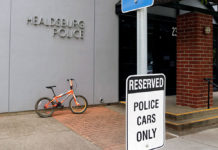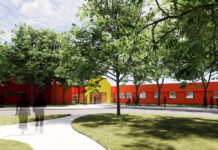Ten native species on protected list
by BERT WILLIAMS, News Editor
Windsor’s native trees will soon be safer, thanks to
modifications of the town’s tree-protection ordinance.
According to Planning Director Peter Chamberlin, increased
efforts to protect the trees got rolling three years ago after a
developer ignored a stop-work order and kept digging close to
native trees. The modified ordinance, introduced at a Town Council
meeting earlier this month, will require appraisal of native trees
by a qualified arborist and substantial security deposits from a
developer before work begins.
“Trees are a source of great beauty, provide shade, and other
environmental benefits, enhance property values, create community
identity, and generally enhance the quality of urban life.” So says
the introductory paragraph of the tree-preservation chapter in the
new zoning ordinance. Ten species of trees have been identified as
native to Windsor. They include eight species of oaks, the
California buckeye and the California bay. The native species are
protected everywhere in town.
Removal of a protected tree requires a permit issued by the
town’s Planning Department. Cutting down or damaging a tree without
a permit is a misdemeanor, punishable by civil penalties of up to
$5,000 per tree, or the replacement value of the tree. Trees not on
the protected list may be removed without a permit.
The Planning Depart-ment has created a Tree Technical Manual
that details methods and requirements for maintaining trees,
replacing trees that are removed and the protection of trees during
construction.
The new ordinance provides for security deposits of up to
$50,000, to be held by the town during construction. If any tree
within the development fails to survive, the town may use the
deposit to purchase new trees to compensate for the loss. Owners of
parcels of one acre or smaller will not be required to provide
security deposits when they develop their land, according to
Chamberlin, but are subject to the other provisions of the
ordinance.
Chamberlin described the development of the ordinance as “a
long, arduous process,” involving several public hearings by the
Town Council and the Planning Commission.
“We have a good ordinance that was born of compromise,” he said.
“The goal is to make it work. To shut down development is not the
goal.”
In its Oct. 1 meeting, the council discussed the fact that the
town itself is exempt from the requirement for security deposits.
Councilmember Sam Salmon expressed concern over the town’s
exemption. “I’ve always felt,” said Salmon, “that the town should
be held to the same standard as developers.” But Councilmember
Steve Allen observed that an ordinance forcing the town to pay a
deposit or a fine to itself would not have much impact.
“What the council made clear,” said Town Manager Paul Berlant,
“is that (the exemption) does not exempt us from the provision of
protecting the trees.”
When preparing a construction site, developers are required by
the ordinance to fence off a Tree Protection Zone around all
protected trees. Depending on the size of the tree, the zone takes
in an area as much as three feet beyond the tree’s drip line.
Workers and equipment must stay outside the zone at all times. The
ordinance also details specific construction requirements which
include grading, landscaping and materials used near trees.
The ordinance recognizes that exceptions will come up from time
to time, including emergency situations, public utility damage and
traffic visibility. It is expected that the ordinance will be
adopted at the council’s Oct. 15 meeting, and will go into effect
one month later.
76
F
Healdsburg
May 24, 2025









